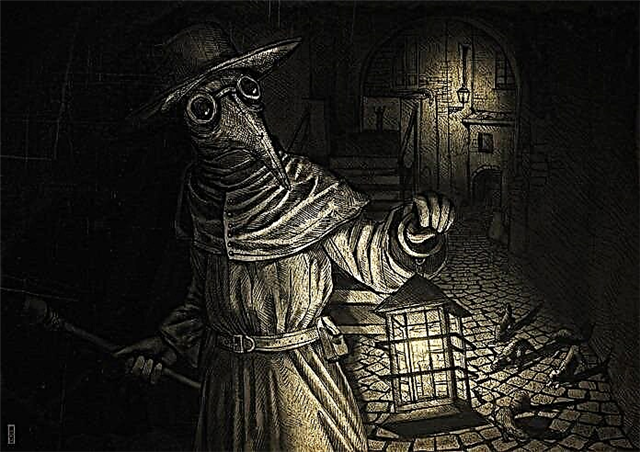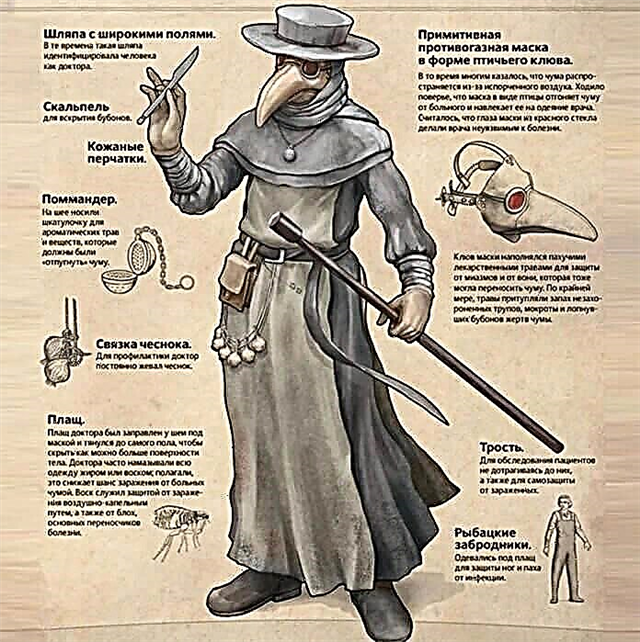The Plague Doctor is a doctor who treats patients with bubonic plague and Black Death. One of the most recognizable figures of the Middle Ages, closely associated with the concepts of "epidemic" and "quarantine." Below we will tell you the most interesting facts about the plague doctors, and you will find out why they wore masks with long beaks, and what methods were used to treat (or, often, torment) their patients.
7. Plague Doctors and Black Death
 One of the worst pandemics in human history, called the Black Death, was an outbreak of bubonic plague. And although plague doctors in their traditional guise are associated primarily with this terrible disease, the costume appeared later than Black Death.
One of the worst pandemics in human history, called the Black Death, was an outbreak of bubonic plague. And although plague doctors in their traditional guise are associated primarily with this terrible disease, the costume appeared later than Black Death.
The famous anti-plague uniform with a bird-like mask was developed by the French doctor Charles de Lorm, who healed many European royalty in the 17th century, including King Louis XIII and Gaston of Orleans. He wrote that during the outbreak of the plague in Paris in 1619, he developed clothing entirely made of Moroccan goat leather, including boots, trousers, a long coat, hat and gloves.
The costume was widely used during the plague of 1656 in Italy. Wearing such an outfit was spelled out in an agreement that every plague doctor concluded with city councils.
However, healers of the plague, albeit without characteristic costumes, really appeared in the 14th century. This began with Pope Clement VI, who in 1348 invited several doctors specifically to treat the inhabitants of Avignon who were affected by the bubonic plague.
6. Costume Features

One of the most interesting facts about plague doctors is related to their extravagant and frightening appearance. The plague doctor looks like a cross between a steampunk-style crow and the Grim Reaper. In Italy, this image was so iconic that the plague doctor became one of the main participants in the Italian comedy of masks and carnival holidays - and remains a popular cosplay character even today.
The costume included the following elements made of waxed leather or oiled canvas:
- long coat,
- shirt
- breeches,
- gloves
- long boots,
- a hat with wide brim, which was supposed to indicate a profession (in case the rest of the costume was too unobvious).
- A cane that was used to examine patients without touching them. Doctors also used these canes to signal their assistants and to drive away the sick family members or himself, who were distraught from grief or fear.
But the most prominent aspect of the uniform was a mask with crystal or glass eyepieces and a long beak, which has a logical explanation. At that time, doctors did not know how the disease actually spread. It has been suggested that the cause of the plague was “poisoned air” (aka “miasma”). A mask filled with a composition of more than 55 herbs and other components, such as viper powder, cinnamon, myrrh and honey, was designed to suppress miasma, thereby protecting the doctor. While the air passed through the long beak, it was "cleaned" and supposedly became safe.
Although the plague doctor’s costume has become a theatrical and creepy symbol of the “wild time” in the history of medicine, in fact it is a visible embodiment of medical myths about the spread and prevention of plague. Every detail of the costume reflects changing ideas about the causes and transmission of the disease, the relationship between doctors and patients, and the role of the state in protecting public health.
5. Burning mask
 Although the patients obviously had a hard time during the plague, their doctors were a little better off. In addition to the risk of getting sick, they were very uncomfortable with their costume.
Although the patients obviously had a hard time during the plague, their doctors were a little better off. In addition to the risk of getting sick, they were very uncomfortable with their costume.
Anyone who has ever worn a medical mask during quarantine knows how unpleasant it is to be after a couple of hours. And imagine what it is like to wear a mask that almost does not allow you to talk, hardly lets you breathe, and you can even see through it badly.
In addition, based on the theory of miasma, some plague doctors in France set fire to aromatic material inside their masks in the hope that smoke would help cleanse bad air. Make a fire near your own face - what could be “more fun"?
4. Plague doctors treated everyone. But not for free
 Given that the plague was so contagious that doctors needed a special suit, it would be easy to assume that they only treated those who could afford it. But that was not the case. The poor may not have been able to afford the treatment, but the plague was so contagious that the rich could not allow the poor to carry it.
Given that the plague was so contagious that doctors needed a special suit, it would be easy to assume that they only treated those who could afford it. But that was not the case. The poor may not have been able to afford the treatment, but the plague was so contagious that the rich could not allow the poor to carry it.
For this reason, city councils hired and paid for the work of plague healers without dividing them into rich and poor patients.
Although the plague doctor post was well paid, it was usually occupied by three types of people:
- novice doctors
- those who had difficulty in private practice,
- volunteers who did not have a medical education, but were willing to try to treat others.
In many cases, cities provided doctors with additional benefits, such as a free home, expenses, and a pension. As a result, the plague doctors, who technically treated patients for free, actually began a lucrative career.
3. Outcasts
 A physician is a prestigious profession in almost all countries of the world (here Russian doctors can grin bitterly, and why is already a topic for a separate article). However, the plague doctors turned out to be a slightly different story.
A physician is a prestigious profession in almost all countries of the world (here Russian doctors can grin bitterly, and why is already a topic for a separate article). However, the plague doctors turned out to be a slightly different story.
They spent so much time with infected people that healthy people, including general practitioners, were afraid to communicate with them.
Although de Lormu was lucky enough to live to an impressive 96 years, most plague doctors became infected and died even when using a suit, and those who did not get sick often lived in constant quarantine. In fact, it can be a lonely and ungrateful existence for someone who saves, or at least tries to save the lives of other people.
2. Duties of the plague doctors
 Oddly enough, the main responsibilities of the plague doctor were not only to treat patients. They were more administrative and time-consuming, since doctors had to take out and bury the corpses, keep records of the victims of the epidemic and cases of cure, do an autopsy or be a witness when drawing up a will and testify in court, if necessary.
Oddly enough, the main responsibilities of the plague doctor were not only to treat patients. They were more administrative and time-consuming, since doctors had to take out and bury the corpses, keep records of the victims of the epidemic and cases of cure, do an autopsy or be a witness when drawing up a will and testify in court, if necessary.
Not surprisingly, this meant that some plague healers took money and valuables from their patients' homes or fled with their last will and testament.
1. Horrible treatments
 Since the doctors treating bubonic plague faced only nightmare symptoms and not a deep understanding of the disease, they resorted to some dubious, dangerous and painful treatment methods.
Since the doctors treating bubonic plague faced only nightmare symptoms and not a deep understanding of the disease, they resorted to some dubious, dangerous and painful treatment methods.
Some practiced coating of buboes - inflamed lymph nodes filled with pus - human excrement. A popular method of treating the plague was bloodletting, and if it didn’t help, the plague doctor could recommend filling the house with incense, burning the buboes with a hot iron or piercing them to drain pus. If this did not benefit the dying poor fellow, he could be treated with arsenic and mercury or given medications that cause “beneficial” vomiting and urination.
Not surprisingly, such treatment attempts often accelerated the death and spread of infection.
However, there were professionals who did not aggravate the torment of patients, but organized more or less effective measures to prevent the spread of the disease. So, Michel Nostradamus, who was not only a famous forecaster, but also one of the plague doctors of his time, in his Treatise on Cooking Jams, recommended separating sick people from healthy people and keeping them in different parts of the city.
Although plague doctors for the most part could not prevent or alleviate the physical torment of the sick, they gave people the ghostly hope of salvation and were often the last to warn the dying.












